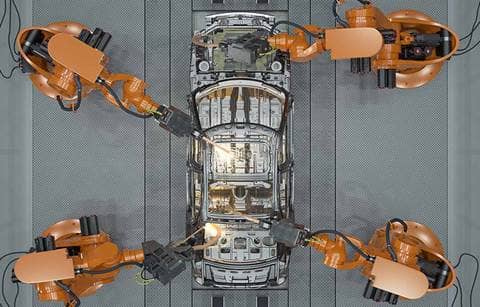What’s not on the radar screens of manufacturing executives, but should be? AI, or artificial intelligence, has the potential to raise the IQ of your plant’s operations and supply chain — to improve quality and efficiency, lower costs, and enhance competitiveness. It’s not just an opportunity for large manufacturers. Small manufacturers need to compete on a global basis with them, and in the future, this won’t be possible without using AI.
If you're wondering how to make better use of AI technology in your manufacturing environment, think about these examples to look at your plant in new ways.
A smarter shop floor and improved quality
Advances in sensor technologies and the ubiquity of the Internet of Things (IoT) directly imply that modern manufacturing equipment will capture data to an unprecedented degree throughout the production process. AI, and more specifically, machine learning, can use this data to identify patterns, trends, and anomalies; draw conclusions; and then predict — and prescribe — optimal actions.
Take the manufacturer using AI in a plant that machines engine components for high-performance vehicles. With the engine's advanced, precision-machining requirements, AI captures and analyzes millions of data points from every operation and inspection station, upon every turn of the mill or drill. Hole geometry. Surface finish. Concentric holes. Subtle changes at the operation, such as a humanly imperceptible rise in heat or vibration, can be detected and analyzed in real time — before the dimensional requirements fall outside of tolerances.
AI can identify parts in real time that may be within specification at one dimension but, when “stacking tolerances” with other parts, would fall out of range once assembled, potentially bringing assembly processes to a halt or creating scrap. For example, one supplier invested in AI software and data analytics to monitor machining performance on parts that weren’t exceeding upper control limits, but consistently on the higher end, creating tolerance issues further down the line.
Or consider an aerospace manufacturer coupling X-ray technology with deep learning networks to detect fatigue cracks in engine turbine blades. With the right imaging technology combined with AI software, you can identify actions to take earlier, before defects would occur and cause part scrap. In other words, AI can support preventative quality assurance throughout the manufacturing process, rather than traditional QC actions after the fact.
Throughput optimization
For manufacturers, the production process is far from perfect; for one thing, it’s not updated or modified fast enough. AI software applications can capture data from machining centers and assembly lines, determining optimal process flow based on machine time per station, part transit, handling, and other factors — even while your product schedule may be changing frequently.
Responsive engineering and design
AI can shorten the feedback loop between customer, production, engineering, and design. Autonomous vehicles (AVs) offer a compelling use case. As hundreds of sensors on an AV capture data about everything from battery state of charge to tire wear, AI can support identifying insights about critical components — say, which parts have been more prone to failure (and when) — and draw conclusions that directly feed back into the engineering and design process for future modifications.
Take Tesla's recent over-the-air software update that improved braking capacity by nearly 20 feet. Using data analytics, they not only improved the vehicle’s safety but saved time, money, and inconvenience to customers regarding conventional repairs.
Enhanced supply chain agility
AI offers huge opportunities for a more nimble and efficient supply chain. With material costs comprising 50 percent or more of manufactured products, optimizing the sourcing, purchasing, scheduling, and delivery processes can save hefty sums. Predictive AI calculations can drive toward faster transportation routes, identify demand patterns for materials and parts needed, reduce inventories, and streamline production schedules to meet customer requirements.
Don’t miss the opportunity
With the urgent demands of day-to-day operations, manufacturing executives aren’t focused on how technology like AI could resolve many of the issues they face — a huge missed opportunity. Learning about AI technology and how it can be put to use in manufacturing is a smart first step.
Start thinking strategically. Using AI should be part of your business's overall digital transformation strategy and requires some ground work. Think toe-in-water, not leap-off-cliff.
Form a team to evaluate where the greatest potential for AI might lie. Not sure where to start? Look for production areas where you have lots of data but aren’t drawing meaningful conclusions. Think about your daily pain points. Now you're getting warmer.
Be sure you have the right technology on hand. For each use case, consider what investments are needed. Do you need to integrate data off of the local server or CNC machines? Do you need to use a different database? If your IT environment is still listening to eight-track tapes, you'll want to remedy that situation first. Preparatory solutions could include:
- Deploying data gathering and IoT devices
- Investing in data analytics and cloud technologies (such as data warehousing, data lakes, system connector technologies)
- Implementing shop floor human computer interaction tools
- Upgrading to enterprise and business systems (like ERP, HRIS, EAM, CRM)
- Operational studies to identify opportunities for AI-enabled point solutions
Many software companies are beginning to incorporate AI into their package products; however, they may not meet your identified needs. Instead, you may need to purchase focused AI-enabled software to address specific use cases.
Develop focused learning and business objectives for each use case. Setting reasonable expectations will enlist critical management commitment. Conduct quick proof of concepts — and implement in 30 days. Then, let the learnings guide you to the next pilot project.
At the end of the day, AI must deliver key business benefits — better parts, lower costs, improved design and engineering, agile supply and distribution, and an edge over your competitors. That's why AI should be on your radar screen.





